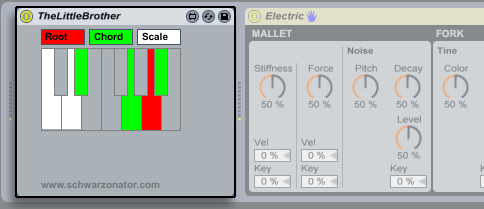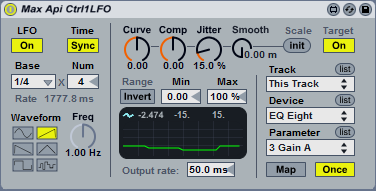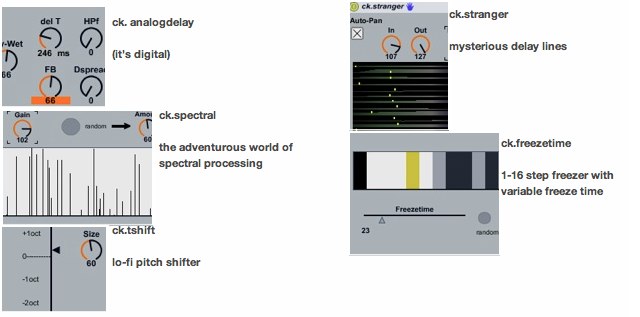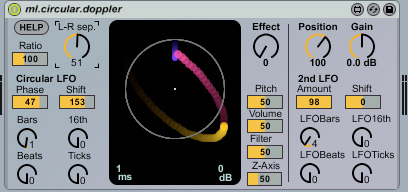As Max for Live matures, Ableton is working to convince more people to try this open-ended tool – and creations built for it – as a way of extending the experience of using Live for performance and production.
For years, music software has focused on trying to do everything you need, to be a solution to problems you haven’t even considered yet. But recently, we’ve seen a move to software that considers customization and extension a core feature – not just the province of the hard-core hacker or DIYer, but something basic to the tool. FL Studio, Renoise, Reaper, Kontakt, and Ableton Live, to name a few, each incorporate tools that allow scripting, customization, and custom instruments, effects, sequencers, and other tools. (Each does it in very different ways, I might add.) In place of from-scratch construction, these tools build on the capabilities of the software in which they’re hosted.
And even if you don’t personally decide to take on scripting or patching, that means you can take advantage of unique contraptions made by other users. These creations aren’t just hacking for hacking’s sake: they meet specific musical needs, and make tools more practical and expressive. Like knowing the reeds on a wind instrument or tuning on a guitar, they’re part of how musicians are able to make their instrument their own.
Of course, unlike a new effect or workflow tweak, getting your users to embrace an open-ended tool takes time, and it may not be for everyone. We’ve been following recent efforts by Ableton to respond to feedback from their user community. While these fall short of the ability to distribute patches to all Ableton Live users – something I and others have advocated – they do make Max for Live more affordable and patches built for it more accessible.
CDM talked to Ableton’s Daniel Büttner in February about some of the changes on the developer side, both in terms of improvements to the tools and guidelines to make patches better:
Ableton Delivers Max for Live Improvements and Guidelines, Responds to Feedback; Full Details
In the last couple of weeks, Ableton has made offerings to the user side.
Max for Live Sale: First, right now you can get Max for Live for less. In the month of April, Max for Live is free with a purchase of Ableton Suite 8 or upgrades to Suite from the Lite and Intro versions. If you have Live 1-8 or Suite 7 and upgrade to 8, unfortunately, Max for Live isn’t free – but it is half off. I’d like to see more aggressive, permanent pricing from Ableton if they want widespread adoption of the tool – it seems to me that offering a “Suite” without this key component is complex for users to understand and makes budgeting for Live needlessly difficult. But that’s my prerogative as a critic and writer, just as it’s their prerogative to determine that what I’m saying doesn’t make sense for their business. In the meantime, I can certainly recommend the Suite purchase if you’re getting Live new or upgrading from an intro edition.
Updated: Current Suite owners qualify for a 30% coupon which they should have received via email, says David from Ableton via comments.
If you’re considering Max for Live but aren’t sure if it’s for you, there’s also a 30-day free trial – always a good bet.
Featuring Max for Live patches: More interesting than the pricing stuff is the fact that you can get some truly spectacular patches for Max for Live, and Ableton is doing more to highlight the work of some of the most talented, creative artists working with the tool.
As readers have repeatedly observed, maxforlive.com is a terrific resource for Max for Live lovers and those wanting fun patches to play with. It now includes a Featured Devices page curated by Ableton’s sound team, with some really great, free stuff.
Ableton has also added both new basic devices – including some oft-requested options, like an LFO – and featured artist creations, too.
Max for Live Highlights from Artists
Artist endorsements can be a mixed bag – they sometimes feel forced, an attempt to get some fame to rub off on a product. Not so here: as with, say, some of the recent gems on the Reaktor side from the likes of Tim Exile, the featured artists working with Max for Live really are pushing the technology and the medium.
Robert Henke, aside from being an Ableton co-founder and conceptually steering a lot of their direction, has one of the best recent Max for Live creations. Monolake helped establish the granular sound on the electronic palette in the 90s, so it’s little surprise that a Henke-designed granular device is a terrific instrument. See the video at top – it’s one of the best reasons yet to try Max for Live.
Kapture by Liine is an eminently-practical entry, sucking all of the parameters in a Live set into snapshots and allowing you to morph through them. I’ve been testing this paired with their iOS app on an iPad, and it’s terrific; I’ll finally talk about it once I’ve wrapped my head around some good examples.
And, I should say, it’s thoroughly enjoyable seeing Richie Hawtin back as Plastikman – the work he’s doing on the tour is exactly the sort of audiovisual electronic performance I hope we see more of from artists famous and unknown alike.
There’s also a House-style beat generator by Alexkid (video, above), and of course the obligatory APC step sequencer (though check out more step sequencers below).
This isn’t just about pure electronic dance music, though. Henrik Schwarz has a new edition of a device that fits notes to a musical scale, as relevant to jazz artists working with electronic instruments as electronica artists. Katsuhiro Chiba makes some classic retro-80s synths that could appeal to keyboardists in a wide variety of genres. I love seeing versions of the Yamaha TX81Z or simple, analog-style Sep2.
The most welcome offering, though, may be the addition of new LFOs, which allow synth-style modulation of any Live devices. Manuel Poletti has a powerful LFO collection with plenty of options for assigning modulation wherever you like. (See our previous, unintentionally-controversial, coverage of LFO modulation in Live, and more examples on the maxforlive.com site.)
Find the artist devices, descriptions, and downloads at the main Ableton Max for Live site:
http://www.ableton.com/maxforlive
New, Essential Devices
Max for Live itself has added 21 devices that give the tool a more complete set of basic building blocks for patchers. That’s good news, in that it means a lot less reinvention – and because the value of Max for Live itself goes way up.
New in the release this spring are LFOs, envelope followers (for using an audio signal to modulate parameters), randomizers, and multichannel routing devices.
Indeed, my only concern here is that many of us hoped to see some of these capabilities in “native” Ableton Live devices, rather than Max for Live patches. An LFO to many users is an essential built-in module that would benefit the software, as it has been in some rival tools, comparable to tools like chord and pitch manipulation for MIDI included in Live.
I don’t know that the LFO per se is necessarily fundamental to Live. But I do hope that Ableton continues to develop native devices for the Live environment. Max for Live could serve a useful purpose here – as a testing bed and prototyping tool, as it has been intended – and aid in determining which tools really do need to be included with Live itself.
More (updated info) on the included devices:
What Comes with Max for Live
And Don’t Forget…
Even with all these Ableton-provided goodies on their site, it’s worth visiting community sites like the unofficial maxforlive.com.
There are some gems at maxforlive.com, including the featured page:
http://maxforlive.com/featured/
— some of those, in turn, chosen by Ableton. Pictures of some of my favorites:
Let us know how you’re using Max for Live, if you find it fits into your workflow or if you focus on the core Ableton software instead. And certainly, if you’re a Max for Live patch developer or user and want to show off your favorites (including your own), we’d love to hear from you.








